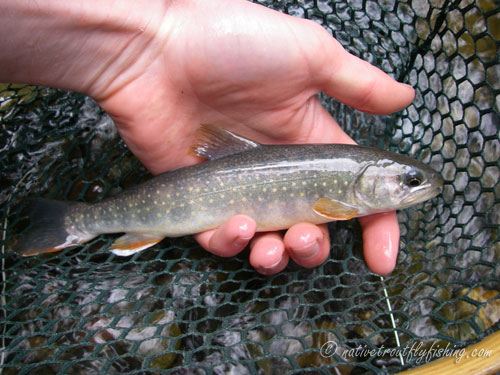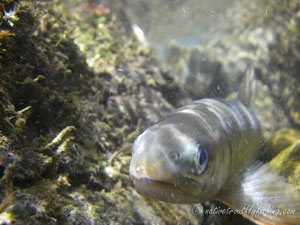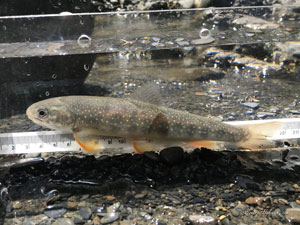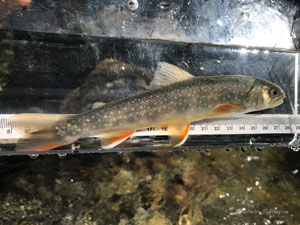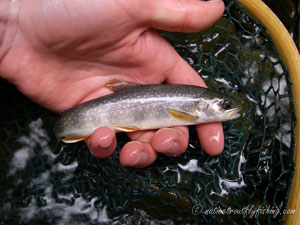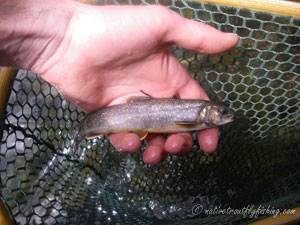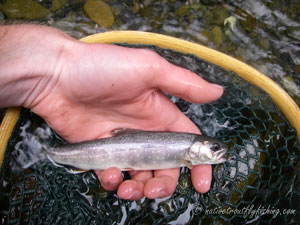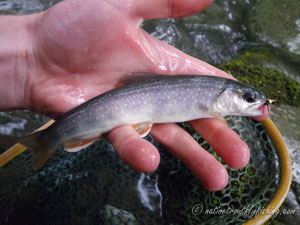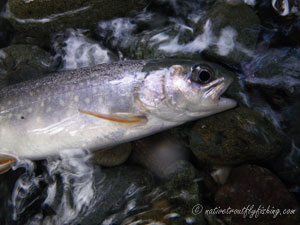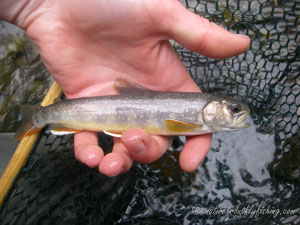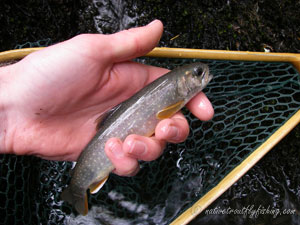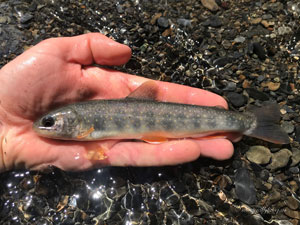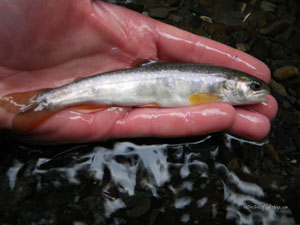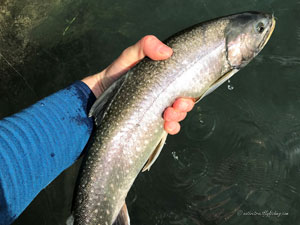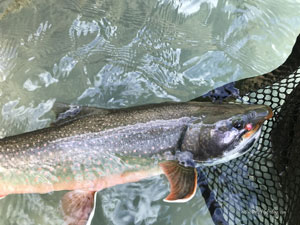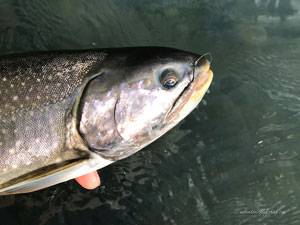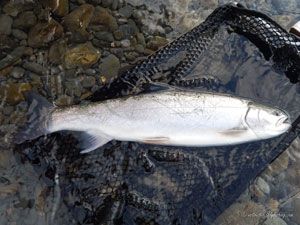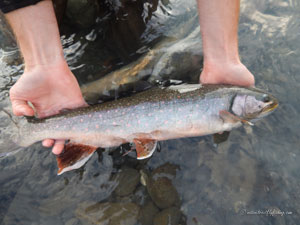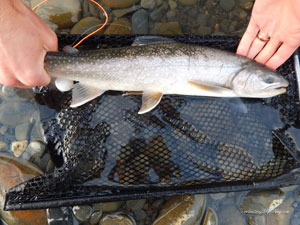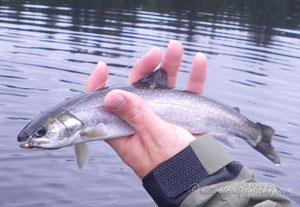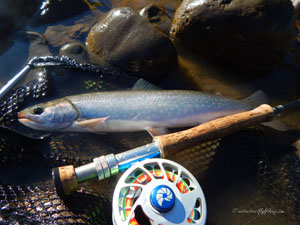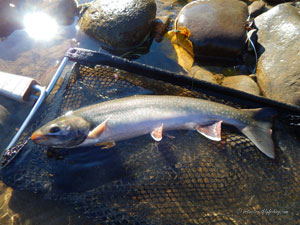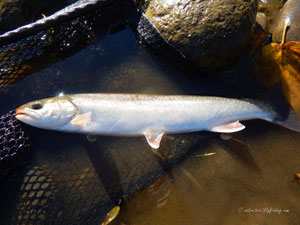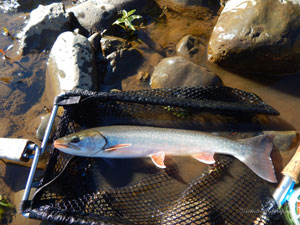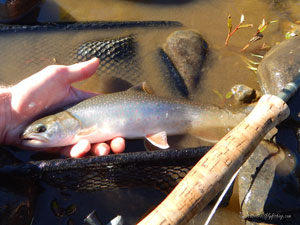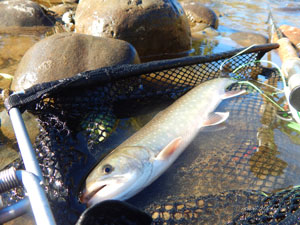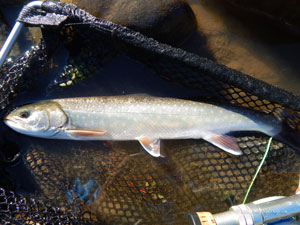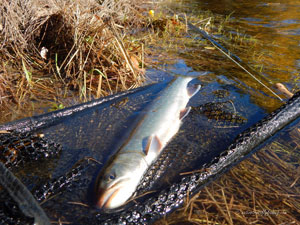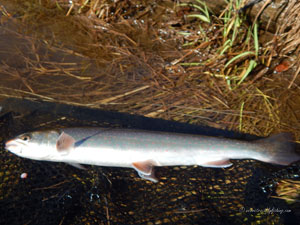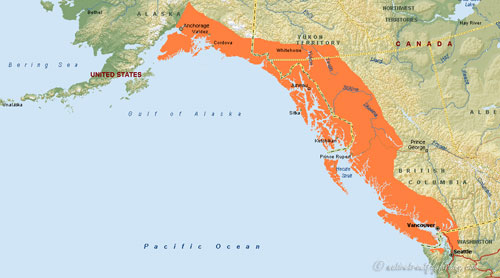Southern Dolly Varden
Salvelinus malma lordi
A Southern Dolly Varden from a stream on the Olympic Peninsula in Washington State.
Introduction
The Southern subspecies of Dolly Varden are native to coastal watersheds from the Susitna River, Alaska south to the Quinault River, Washington. Despite their beauty and quality as a game fish, Dolly Varden are still recovering from a bad reputation as ravenous predators of eggs and juvenile salmon. This resulted in Alaska putting a bounty on these fish between 1921 and 1939, which ironically led to the extermination of far more rainbow trout and coho salmon than Dolly Varden. Today we understand that Dolly Varden typically eat the loose surplus or diseased eggs and fry, which can reduce the risk of disease in salmon populations. Dolly Varden are seen indicators of the health of watersheds as they require cold clean water to survive.
Life History Information
Southern Dolly Varden exhibit four distinct life histories, anadromous, lacustrine, fluvial and stream resident. As general life history characteristics go, most adults generally reach sexual maturity at between the age of three and six years old. Dolly Varden are fall spawning fish and once they reach maturity, they typically spawn on an annual basis. Eggs hatch during the spring and alevin emerge from the gravel from late April to mid-May at around ¾” to 1” (20-25mm) long. Southern Dolly Varden fry primariy utilize small pools and eddies along stream banks where the flow is slower (Blackett 1968). In early summer, they can also be found in very small rivulets with depths of 0.5- 1.5 inches and widths less than 3 feet (Armstrong and Elliott 1972). After their first year of life, juveniles use a variety of habitats, including areas of still or moving water, gravel or muddy substrate, dense vegetation, or even in open water with little or no vegetation (Heiser 1966). Armstrong and Elliot (1972) showed that they appear to prefer undercut bank areas along the stream.
Isolated stream resident populations are relatively common at the southern end of the the Dolly Varden's native range. Fish from these stream resident populations are typically very slow growing and reach sexual maturity after three or four years old at a size of only 4" to 6". Stream resident Dollies tend to feed primarily subsurface on aquatic insects, but will take advantage of other prey items when available. Stream resident fish often remain in a rather short section of stream throughout their entire life, whereas fluvial individuals actively migrate to a larger stream to feed and overwinter. The fluvial fish will generally home back to their natal stream for spawning during the fall.
Due to their diet, most lacustrine Dolly Varden do not attain very larger sizes, and they generally weigh less than 1 lb (Amrstrong and Hermans 2000). The typical lifespan of these fish is around 8 to 10 years. Exceptions are Dolly Varden weighing up to 9 lb in lakes that contain kokanee, these larger fish feed on kokanee and tend to live longer, up to 19 years (Armstrong 1991). The typical diet of lake dwelling Dollies is primarily made up of invertebrates (aquatic insects), but they will prey on salmon fry when available. Some lacustrine populations of Dolly Varden also feed heavily on freshwater snails. This provides an important service as these snails host a parasite that is known to infect the eyes of juvenile coho and sockeye salmon and eventually cause blindness (ADFG 2006). Andrew (1975) showed that in lakes where southern Dolly Varden co-occurred with cutthroat the cutthroat tended to inhabit the surface waters while that Dolly Varden utilized the deeper waters of the lakes. However in lakes containing only Dolly Varden the fish were more of generalist and occupied all depths showing that the cutthroat tend to dominate over the Dollies when the two occupy the same lake.
Anadromous Dolly Varden are slow growing and generally spend three to four years rearing in freshwater before migrating to marine waters for the first time (Smith and Slaney 1980). During this period, before the fish out-migrate, they appear to use a variety of habitats and can be found in most accessible portions of the streams (Armstrong and Morrow 1980). The diet of these pre-smolts may include insects, eggs and salmon fry (generally pink and chum). Most smolt migrations occur during May and June, although some populations in SE Alaska have been shown to out-migrated during the fall (Armstrong 1970). Once in marine waters, Dolly Varden feed on a variety of items including capelin (50-75%), Pacific Sandlance (7-19%), polychaete worms (4-5 %), herring, crustaceans and salmon fry (Lagler and Wright 1962).It is typical for anadromous southern Dolly Varden to overwinter in lakes and Armstrong (1974) showed that fish from watersheds without lakes will often enter several streams while searching for one with a lake. Overwintering in lakes appears increase the survival and longevity of Dollies, as many of these lakes approach 32 degrees (F) during the winter, which means that little if any feeding is required for the fish to survive (Armstrong and Hermans 2000). Returning dollies tend to have rather high homing fidelity and are known to migrate into the uppermost reaches of their natal streams (Armstrong and Hermans 2000; Bryant et al. 2004). It is estimated that 70% of male and 50 to 60% of female sea-run dollies die after spawning and most males do not spawn more than twice, while the females may spawn three times (ADFG 2006).
Status
While southern Dolly Varden are susceptible to declines due to habitat degradation, they are still common and fairly abundant throughout much of their native range. Currently there are no populations of these fish listed on the Endangered Species act. The primary reason for this is that most populations occur in remote areas, leading to lower levels of exploitation This does not mean that Dollies haven’t seen declines as a variety of issues have lead to localized extinctions or population reductions. In British Columbia, Canada southern Dolly Varden are blue-listed, which means that this species is considered vulnerable. They are sensitive to habitat changes, including disruption of migration routes,sedimentation and increasing water temperature. Many populations have declined as a result of urbanization, dam construction, industrial activity, road building or over-fishing (including poaching) (BCMOF 2012). Southern Dolly Varden are especially susceptible to over-harvest, and in the Juneau AK area, over the period of only eight years, the catch rate dropped from more than four Dolly Varden per angler hour to less than 0.2 fish per angler hour (Armstrong 1991). Fortunately this problem can typically be remedied by more restrictive regulations.
Historically Dolly Varden suffered from a bad reputation as voracious predators of eggs and juvenile salmon, which led to a federal bounty being placed on them in Alaska between 1921 and 1939. The aim of this bounty was eradicate them from Alaska’s salmon bearing streams to increase salmon survival. With this bounty the government paid two to five cents per tail, however of the 6 million tails that were turned in, 71% were from coho salmon and 19% were from rainbow trout (Behnke 2002). It is now understood that Dolly Varden “predation” on salmon eggs actually provides an ecosystem service as free drifting salmon eggs die anyways and often become infected with fungi which posses a serious risk to salmon population (ADFG 2006). On top of that yearling coho and cutthroat trout are much more serious predators of juvenile salmon than Dolly Varden.
Habitat degradation may be one of the greatest threats to Dolly Varden across their range and clear-cut logging, stream channelization, and urban development are among the leading problems. The habit of young Dolly Varden to rear in small stream tributaries and even intermittent rivulets puts them at risk from certain types of development, especially logging. Improper logging practices can be extremely damaging, leading to increased sedimentation, stream temperatures and loss of cover. The problem is exacerbated by the extremely wet climate during winter months throughout this region, which increases the chances of landslides and other mass wasting events. Dry summers in the region can lead to elevated stream temperatures and even complete drying of streams that have been cleared of riparian vegetation. In the past it was a relatively common practice to “clean” streams of wood debris following logging events. However Dolloff (1986) showed that his practice led to a decrease in the carrying capacity of young coho and Dolly Varden in these streams. Such removal causes a reduction of pool habitat and an overall increase in the water velocity. Elliot (1986) indicated a substantial decrease in Dolly Varden numbers as well a decrease in body size in streams that had been cleaned of wood debris.
Description
The name Dolly Varden comes from a character in Charles Dicken's novel Barnaby Rudge, who favored brightly colored dresses. With the highly vivid colors that Dolly Varden are known to exhibit, especially as they near spawning, the name seems to fit. Both subspecies of Dolly Varden are often confused with bull trout and arctic char, which also occur across much of their range. In fact the name Dolly Varden was first applied to char from the McCloud River in California, which in actuality were bull trout. To the untrained eye, it often requires genetic analysis to differentiate from these other look-alike char. Despite this confusion, there are subtle differences in appearance that can help to identified Dollies in the field. The first of these would be the length of the jaw, which tends to be much shorter than bull trout’s and typically only extends as far back as the eye. The tail of Dolly Varden is rather squared off as compared to the forked tails of arctic char. The coloration of southern Dolly Varden can very to a great degree, but generally their background color is grayish-blue to green, with a yellow or orange/reddish color along the belly. Spots range from creamy yellow to a pink or red color. Anadromous individuals develop a silvery coloration that may mask their background color and spots.
Stream Resident Form
Click on images to view a larger picture
Native Range
Above: A map of the original native range of the Soutern Dolly Varden. Data Source: Behnke (2002) Below: An interactive map of the native range of the Southern Dolly Varden.
References
ADFG. 2006. Southcentral Alaska wild Dolly Varden. Alaska Department of Fish and Game, Anchorage, AK.
Andrew, J.H. 1975. Habitat shifts and behavioral interactions between sympatric and experimentally allopatric cutthroat and Dolly Varden char. Master's Thesis. University of British Columbia, Vancouver, BC, Canada.
Armstrong, R.H. 1970. Age, food, and migration of Dolly Varden smolts in Southeastern Alaska. Journal of the Fisheries Research Board of Canada 27(6): 991-1004.
Armstrong, R.H. and S.T. Elliott. 1972. A study of Dolly Varden in Alaska. Alaska Department of Fish and Game, Federal Aid in Fish Restoration, Annual Progress Report, 1971-1972, Project F-9-4-13:1-34.
Armstrong, R.H. 1974. Migration of anadromous Dolly Varden (Salvelinus malma) in Southeastern Alaska. Journal of the Fisheries Research Board of Canada 31(4): 435-444.
Armstrong, R.H. and J.E. Morrow. 1980. The Dolly Varden. In: Charrs – Salmonid Fishes of the Genus Salvelinus (ed. E. K. Balon), pp. 99–140. Dr W. Junk, The Hague.
Armstrong, R.H. 1991. Dolly Varden char. Pages 266-272 in Judith Stolz and Judith Schnell, editors. Trout: the wildlife series. Stackpole Books, Harrisburg, Pennsylvania.
BCMOF (British Columbia Ministry of Fisheries). 2012. B.C. fish facts: Dolly Varden (Salvelinus malma). Retrieved from: http://www.gofishbc.com/documents/pdf/fish-facts/Dolly_Varden.pdf
Behnke, R.J. 2002. Trout and Salmon of North America. Chanticleer Press, New York.
Blackett, R.F. 1968. Spawning behavior, fecundity and early life history of anadromous Dolly Varden Salvelinus malma (Walbaum) in Southeastern Alaska. Alaska Department. of Fish and Game Research Report 6:1-85.
Bryant, M.D., N.D. Zymonas and B.E. Wright. 2004. Salmonids on the fringe: abundance, species composition, and habitat use of salmonids in high-gradient headwater streams Southeast Alaska. Transactions of the American Fisheries Society 133(6): 1529-1538.
Dolloff, C.A. 1986. Effects of stream cleaning on juvenile coho salmon and Dolly Varden in Southeast Alaska. Transactions of the American Fisheries Society 115(5) 743-755.
Elliott, S.T. 1986. Reduction of a Dolly Varden population and macrobenthos after removal of logging debris. Transactions of the American Fisheries Society 115(3): 392-400.
Heiser, D.W. 1966. Age and growth of anadromous Dolly Varden Salvelinus malma (Walbaum) Eva Creek, Baranof Island, southeastern Alaska. Alaska Department of Fish and Game, Research Report (5): 1-29.
Lagler, K.F. and A.T. Wright. 1962. Predation of the Dolly Varden, Salvelinus malma, on young salmons, Oncorhynchus spp., in an estuary of Southeastern Alaska. Transactions of the American Fisheries Society 91(1): 90-93.
Smith, H.A. and P.A. Slaney. 1980. Age, growth, survival and habitat of anadromous Dolly Varden (Salvelinus malma) in the Keogh River, British Columbia. Ministry of Environment, Vancouver, B.C., Canada. Fisheries Management Report No. 76.
Taylor, E.B. and S.L. May-McNally. 2015. Genetic analysis of Dolly Varden (Salvelinus malma) across its North American range: evidence for a contact zone in southcentral Alaska. Canadian Journal Fisheries and Aquatic Sciences 72: 1-10.
Contact
Feel free to contact me if you have any questions or comments
Native Trout Links
California Heritage Trout Challenge
Truchas Mexicanas' - Native Trout of Mexico
Balkan Trout Restoration Group
Trout and Seasons of the Mountain Village - About Japanese Trout
Fly Fishing Blogs
Dave B's Blog: Fly Fishing for Native Trout
The Search for Native Salmonids
Conservation Links
Western Native Trout Initiative
Fly Fishing Links
Fishing Art Links
Americanfishes.com - Joseph R. Tomelleri
